UK auto maker Lotus has released initial details of its proposed electric vehicle architecture, developed through the Project LEVA (Lightweight Electric Vehicle Architecture) research program announced last October.
The initiative is focused on accelerating the development of lightweight structures for the next generation of BEVs and the result is, says Lotus, a rear structure 37% lighter than on the Lotus Emira V6, providing a blueprint for the company’s future product lines.
The new subframe features a battery pack employing cylindrical cells, coupled with the option of a single or twin electronic drive unit (EDU). The structure is also designed to be modular to accommodate a variety of vehicle layouts.
Depending on the application, either a ‘chest’ type battery installation – using eight or 12 modules and giving a capacity of either 66kWh or 99kWh – or a floor mounted 66kWh ‘slab’ type pack will be used.
 Richard Moore, executive director, engineering, Lotus Cars, commented, “Project LEVA and the electric sports car architecture are perfect illustrations of the innovation which continues to be at the heart of everything Lotus does. Today’s EVs are heavy in comparison to their ICE equivalents, so the ARMD funding has helped Lotus to innovate earlier in the product cycle and develop a new vehicle architecture that targets lightweight and performance density from conception. Rather than developing a single vehicle, it means Lotus now has the ‘blueprint’ for the next generation of electric sports cars, for future Lotus products and for the Lotus Engineering consultancy to commercialize.”
Richard Moore, executive director, engineering, Lotus Cars, commented, “Project LEVA and the electric sports car architecture are perfect illustrations of the innovation which continues to be at the heart of everything Lotus does. Today’s EVs are heavy in comparison to their ICE equivalents, so the ARMD funding has helped Lotus to innovate earlier in the product cycle and develop a new vehicle architecture that targets lightweight and performance density from conception. Rather than developing a single vehicle, it means Lotus now has the ‘blueprint’ for the next generation of electric sports cars, for future Lotus products and for the Lotus Engineering consultancy to commercialize.”
Project LEVA has been led by engineer Richard Rackham, head of vehicle concepts at Lotus and best known for his work on development of the extruded aluminum Lotus Elise architecture 25 years ago, who said, “Project LEVA is as revolutionary now as the Elise architecture was in 1996. In true Lotus spirit, significant weight savings have been achieved throughout, with a focus on ultimate performance, efficiency and safety being engineered into the structure from the outset – for example, by utilizing the vehicle structure as the battery enclosure, having an integrated EDU, eliminating bolt-on subframes and optimizing the multi-link suspension components.”



